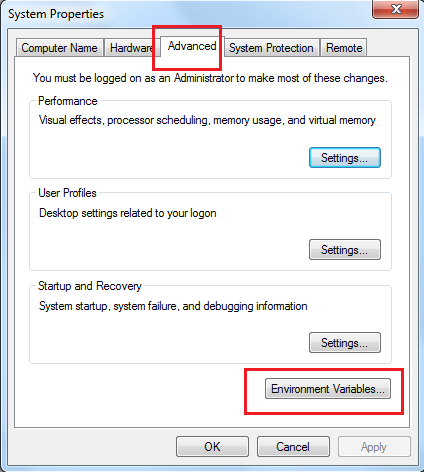Installing on Windows¶
Note
Before you begin:
- See our compatibility matrix to find out if this version of the product is fully tested on Windows.
Follow the instructions below to install API Manager on Windows.
Installing the required applications¶
- Be sure your system meets the Installation Prerequisites. Java Development Kit (JDK) is essential to run the product.
- Be sure that the
PATHenvironment variable is set to "C:\Windows\System32", because thefindstrwindows exe is stored in this path.
Installing the API Manager¶
- Download WSO2 API Manager 3.2.0.
- Extract the archive file to a dedicated directory for the API Manager, which will hereafter be referred to as
<API-M_HOME>.
Installing and setting up snappy-java¶
- Download the
snappy-java_1.1.1.7.jarfrom here. - Copy the jar to
<API-M_HOME>\repository\components\lib. - If the API Manager server is currently running, restart it to apply the changes.
Setting up JAVA_HOME¶
You must set your JAVA_HOME environment variable to point to the directory where the Java Development Kit (JDK) is installed on the computer. Typically, the JDK is installed in a directory under C:/Program Files/Java , such as C:/Program Files/Java/jdk1.8.0_xx. If you have multiple versions installed, choose the latest one, which you can find by sorting by date.
Info
Environment variables are global system variables accessible by all the processes running under the operating system. You can define an environment variable as a system variable, which applies to all users, or as a user variable, which applies only to the user who is currently logged in.
You set up JAVA_HOME using the System Properties, as described below. Alternatively, if you just want to set JAVA_HOME temporarily for the current command prompt window, set it at the command prompt.
Setting up JAVA_HOME using the system properties¶
-
Right-click the My Computer icon on the desktop and click Properties.
-
In the System Properties window, click the Advanced tab, and then click Environment Variables.

-
Click New under System variables (for all users) or under User variables (just for the user who is currently logged in).
-
Enter the following information:
- In the Variable name field, enter:
JAVA_HOME - In the Variable value field, enter the installation path of the Java Development Kit, such as:
c:/Program Files/Java/jdk1.8.0_xx
- In the Variable name field, enter:
The JAVA_HOME variable is now set and will apply to any subsequent command prompt windows you open. If you have existing command prompt windows running, you must close and reopen them for the JAVA_HOME variable to take effect, or manually set the JAVA_HOME variable in those command prompt windows as described in the next section. To verify that the JAVA_HOME variable is set correctly, open a command window (from the Start menu, click Run, and then type CMD and click Enter) and execute the following command:
set JAVA_HOME
The system returns the JDK installation path. You are now ready to run the product.
Setting JAVA_HOME temporarily using the Windows command prompt (CMD)¶
You can temporarily set the JAVA_HOME environment variable within a Windows command prompt window (CMD). This is useful when you have an existing command prompt window running and you do not want to restart it.
-
In the command prompt window, enter the following command where
<JDK_INSTALLATION_PATH>is the JDK installation directory and press Enter.set JAVA_HOME=<JDK_INSTALLATION_PATH>For example:
set JAVA_HOME=c:/Program Files/java/jdk1.8.0_xxThe
JAVA_HOMEvariable is now set for the current CMD session only. -
To verify that the
JAVA_HOMEvariable is set correctly, execute the following command:set JAVA_HOME -
The system returns the JDK installation path.
Setting system properties¶
If you need to set additional system properties when the server starts, you can take the following approaches:
- Set the properties from a script : Setting your system properties in the startup script is ideal, because it ensures that you set the properties every time you start the server. To avoid having to modify the script each time you upgrade, the best approach is to create your own startup script that wraps the WSO2 startup script and adds the properties you want to set, rather than editing the WSO2 startup script directly.
- Set the properties from an external registry : If you want to access properties from an external registry, you could create Java code that reads the properties at runtime from that registry. Be sure to store sensitive data such as username and password to connect to the registry in a properties file instead of in the Java code and secure the properties file with the secure vault.
You are now ready to run the product.
Top